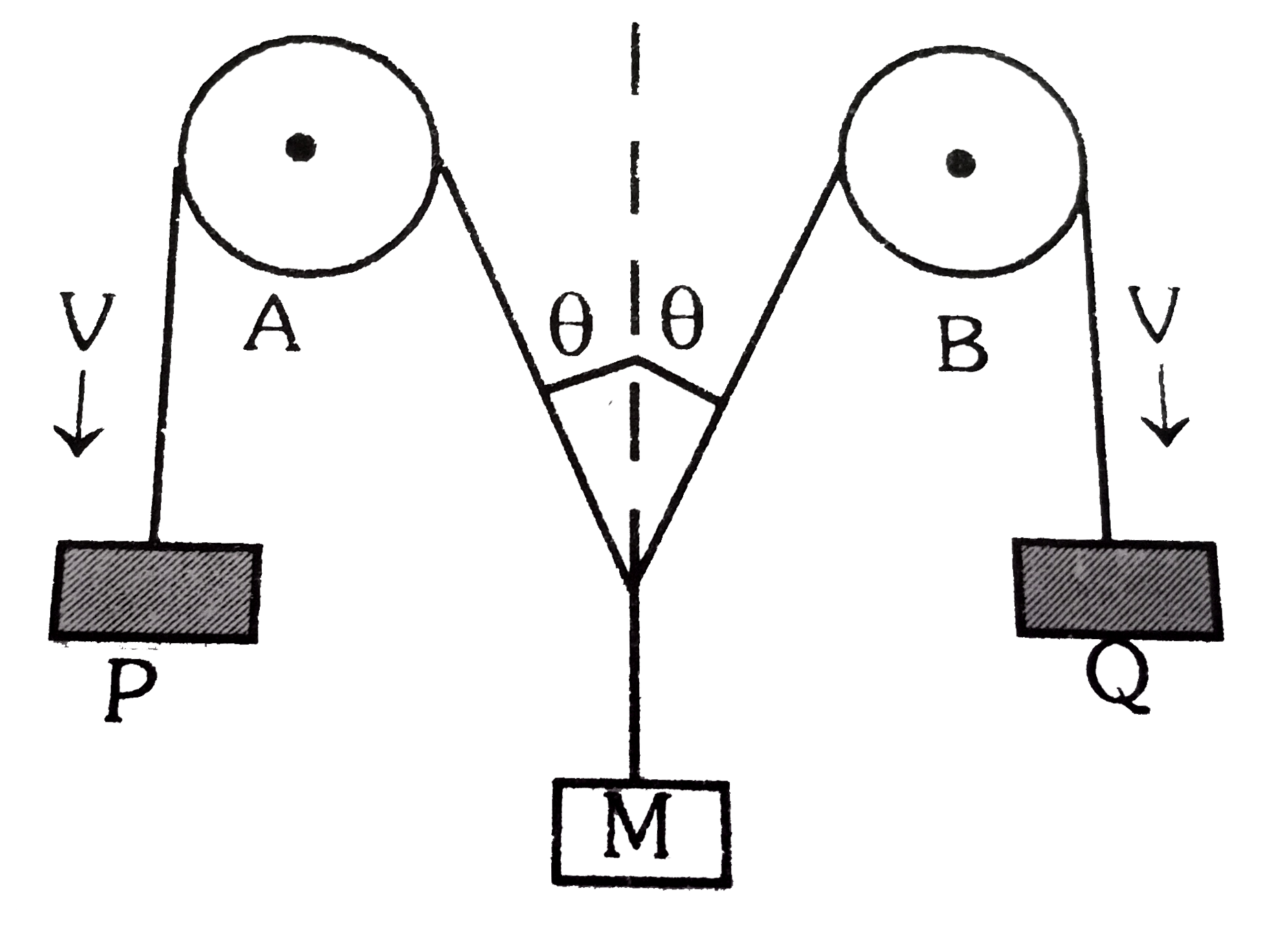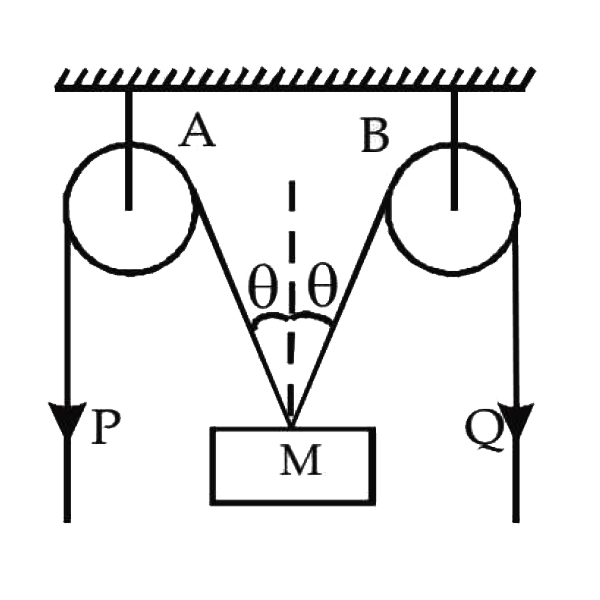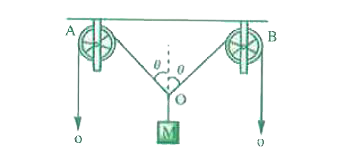In the fig., the ends P and Q of an unstrechable string move downwards with uniform speed V. Mass M moves upwards with speed.
 Solution in Gujrati
Solution in Gujrati
vcosθ
vcosθ
2vcosθ
2vcosθ
The correct Answer is:B

Here x2=y2+d2
So 2xdxdt=2ydydt⇒dydt=(xy)(dxdt)=(xy)(v)=vcosθ
OR
Component of velocity along string must be same
so vMcosθ=v⇒vM=vcosθ
Topper's Solved these Questions
- KINEMATICSBOOK - ALLEN CHAPTER - KINEMATICSEXERCISE - EXERCISE-02
57 Videos
- KINEMATICSBOOK - ALLEN CHAPTER - KINEMATICSEXERCISE - EXERCISE-03
6 Videos
- KINEMATICSBOOK - ALLEN CHAPTER - KINEMATICSEXERCISE - EXERCISE-2
89 Videos
- ERROR AND MEASUREMENTBOOK - ALLEN CHAPTER - ERROR AND MEASUREMENTEXERCISE - Part-2(Exercise-2)(B)
22 Videos
- KINEMATICS (MOTION ALONG A STRAIGHT LINE AND MOTION IN A PLANE)BOOK - ALLEN CHAPTER - KINEMATICS (MOTION ALONG A STRAIGHT LINE AND MOTION IN A PLANE)EXERCISE - BEGINNER S BOX-7
8 Videos
Similar Questions
A particle is moving in a plane with velocity given by →u=u0ˆi+(aωcosωt)ˆj, where ˆi and ˆj are unit vectors along x and y axes respectively. If particle is at the origin at t=0. Calculate the trajectory of the particle :-
View SolutionThe equation of one dimensional motion of the particle is described in column I. At t=0, particle is at origin and at rest. Match the column I with the statement in Column II.
Column IColumn II(A)x=(3t2+2)m(p)Velocity of particle at t=1s is 8m/s(B)v=8tm/s(q)Particle moves with uniform acceleration(C)a=16t(r)Particle moves with variable acceleration(D)v=6t−3t2(s)Particle will change its direction some time
View SolutionA student performs an experiment to determine how the range of a ball depends on the velocity with which it is projected. The "range" is the distance between the points where the ball lends and from where it was projected, assuming it lands at the same height from which it was projected. It each trial, the student uses the same baseball, and launches it at the same angle. Table shows the experimental results.
∣∣ ∣ ∣ ∣ ∣ ∣∣TrailLaunch speed(m/s)Range(m)110822031.833070.7440122.5∣∣ ∣ ∣ ∣ ∣ ∣∣
Based on this data, the student then hypothesizes that the range, R, depends on the initial speed v0 according to the following equation : R=Cvn0, where C is a constant and n is another constant.
Based on this data, the best guess for the value of n is :-
View SolutionA cube has a side of length 1.2×10−2m. Calculate its volume.
View SolutionA football player kicks a ball at an angle of 30∘ with an initial speed of 20 m/s. Assuming that the ball travels in a vertical plane, calculate (a) the time at which the ball reaches the highest point (b) the maximum height reached (c) the horizontal range of the ball (d) the time for which the ball is in the air, (g=10m/s2)
View SolutionIn the arrangement shown in figure the ends P and Q of an inextensible string move downwards with uniform speed u. Pulleys A and B are fixed. The mass M moves upwards with a speed
View SolutionA stone of mass m tied to a string of length l is rotated in a circle with the other end of the string as the centre. The speed of the stone is v. If the string breaks, the stone will move
View SolutionIn the arrangement shown in the Fig, the ends P and Q of an unstretchable string move downwards with uniform speed U. Pulleys A and B are fixed.
Mass M moves upwards with a speed

View SolutionIn the arrangement shown in Fig the ends P and Q of an unstrechable string move downwards with uniform speed U pulley A and B are fixed Mass M moves upward with a speed
View SolutionIn the arrangement shown in figure, the ends P and Q of an inextensible string move downwards with uniform speed u . Pulleys A and B are fixed. The mass m moves upwards with a speed
View SolutionIn the arrangement shown in the fig. the ends P and Q color of a string are being moved downwards with a speed of v each. The pulleys are fixed. The mass M moves upwards with a speed of :
View SolutionIn the arrangement shown in figure the ends of an in extensible string move downwards with uniform speed u. Pulleys A and B are fixed. Find the speed with which the mass Mmoves upwards.

View SolutionIn the arrangement shown in figure the ends of an in extensible string move downwards with uniform speed u. Pulleys A and B are fixed. Find the speed with which the mass Mmoves upwards.

View Solutionचित्रानुसार P व Q नीचे की ओर V वेग से गतिशील है। M द्रव्यमान का ऊपर की ओर वेग होगा :

View SolutionIn the arrangement shown in figure the ends P and Q of an inextensible string move downwards with uniform speed u. Pulleys A and B are fixed. The mass M moves upwards with a speed
View SolutionA stone of mass m tied to a string of length l is rotated in a circle with the other end of the string as the centre. The speed of the stone is v. If the string breaks, the stone will move
View Solution
